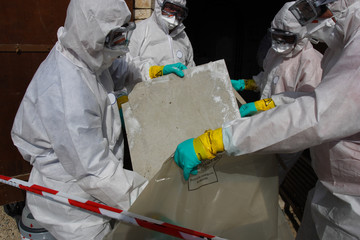For centuries, asbestos has been a popular material in numerous industries, especially construction due to its insulating abilities and resistance to fire. New Zealand’s building industry extensively utilized this substance for decades, featuring it predominantly in the likes of ceiling tiles until its detrimental health effects were irrefutable. This article examines the history of asbestos ceilings found within New Zealand homes while investigating their consequences plus ways you can identify them and handle any encounter with caution.
What is Asbestos?
Asbestos refers to a group of six naturally occurring fibrous minerals composed of thin, needle-like fibers. Due to its resistance to heat, electricity, and corrosion, it was a popular additive in various building materials, including “asbestos ceilings NZ” and “asbestos in ceiling tiles”. However, when asbestos fibers are disturbed, they may release into the air and pose severe health risks when inhaled.
The Rise and Fall of Asbestos Ceilings in New Zealand
Asbestos found extensive usage in diverse applications, with asbestos ceilings gaining immense popularity owing to their economical prices along with sound insulation properties and fire resistance. This article delves into the growth followed by a decline of asbestos ceilings within New Zealand’s history while highlighting crucial events, health risks as well as regulatory alternations.
The Golden Era of Asbestos
In the early 1900s, asbestos was considered a groundbreaking material for construction. Its advantageous characteristics and multifaceted utility resulted in its extensive usage across various building ventures throughout New Zealand. Asbestos ceilings were pervasive elements of both residential and commercial structures within the country due to their numerous benefits:
- Sound Insulation: Asbestos ceilings were a favored option for sound insulation in residential buildings seeking to minimize noise, given their superb performance in this aspect.
- Fire Resistance: The fire-resistant properties of asbestos made it a popular choice for ensuring safety in buildings.
- Affordability: The affordability of asbestos ceilings made them an appealing choice for both builders and homeowners due to their cost-effectiveness.
- Durability: Asbestos was acknowledged for its ability to remain sturdy over extended periods, guaranteeing that ceilings would stay intact for decades.
The Turning Point
Asbestos was once praised for its practical advantages, but apprehension regarding health hazards surfaced as early as the 1920s. Only during the second half of the previous century did it become irrefutable that asbestos exposure causes severe medical conditions. The turning point in New Zealand’s use of asbestos ceilings occurred at this time period.
- Asbestosis: Asbestos-related lung damage, known as asbestosis, was among the initial health concerns linked to exposure to asbestos fibres. Its symptoms include respiratory difficulties and scarring of pulmonary tissue.
- Lung Cancer: There is a growing recognition of the hazards posed by asbestos-containing materials due to their significant connection with an increased risk of lung cancer.
- Mesothelioma: Mesothelioma is a rare and aggressive cancer that directly correlates with asbestos exposure, impacting the lining of either one’s lungs, abdomen or heart.
Regulatory Changes
New Zealand started imposing more stringent rules concerning the use of asbestos in construction, as the hazards to health became increasingly evident.
- 1970s: In the 1970s, regulations were implemented to reduce asbestos exposure in workplaces with high levels of asbestos usage. The aim was to minimize health risks associated with this hazardous substance.
- 1980s: During the 1980s, comprehensive measures were taken in New Zealand to tackle the problem of safety with increased awareness campaigns and stricter guidelines.
- 2016 Ban: In 2016, a ban was imposed on the importation of asbestos-containing products in New Zealand as a result of relentless efforts. This crucial measure marked the end of an era where asbestos usage prevailed within the country.
Identifying Asbestos Ceilings in Your Home

There is a possibility that your home might have ceilings made of asbestos if it was constructed or refurbished before the 1990s. Below are some helpful tips for recognizing them:
- Age of Building: Buildings erected from the 1940s to the 1990s might contain asbestos in their ceiling tiles or other materials.
- Visual Inspection: When conducting a visual inspection, it can be observed that asbestos tiles typically exhibit specific characteristics such as an off-white hue and a slightly dimpled or popcorn texture.
- Professional Testing: If you want to be absolutely certain that asbestos is present, the only reliable method is professional testing. It’s essential to collect samples and have them examined by a certified laboratory.
Health Risks Associated with Asbestos Ceilings
When asbestos ceiling tiles are intact, they generally do not pose a health risk. The danger occurs when these tiles are damaged, disturbed, or deteriorate over time, releasing fibers into the air. Inhalation of these fibers can lead to:
- Asbestosis: A chronic lung condition causing shortness of breath and increased risk of lung infections.
- Lung Cancer: A significant increase in the likelihood of developing lung cancer.
- Mesothelioma: A rare and aggressive cancer that affects the lining of the lungs, chest, or abdomen.
Dealing with Asbestos Ceilings in NZ Homes
| Action | Description |
| Leave Undisturbed | If the asbestos ceiling is in good condition, the best course of action might be to leave it undisturbed. Disturbing it may release fibers into the air and increase health risks. |
| Encapsulation | Encapsulation involves covering the asbestos ceiling with a new material. This method seals in the asbestos fibers and prevents them from becoming airborne. |
| Removal | Removal should be the last resort due to the risks involved and must be done by a licensed professional. The process involves specialized techniques to minimize fiber release and is usually more expensive than encapsulation. |
Conclusion
The history of asbestos ceilings in New Zealand homes is a cautionary tale of a widely used material that turned out to be hazardous. While the use of asbestos has significantly declined and regulations have tightened, many homes still bear the legacy of this once-popular material. Knowing how to identify and handle asbestos ceilings is crucial for maintaining a safe living environment. With proper management and awareness, the risks associated with “asbestos ceilings NZ” and “asbestos in ceiling tiles” can be significantly mitigated. If you suspect your home may have asbestos, take the necessary precautions and consult with professionals to ensure your and your family’s safety.
FAQs
Q: How common are asbestos ceilings in New Zealand homes?
A: They were very common in homes built or renovated from the 1940s to the 1990s.
Q: Can I remove asbestos ceilings myself?
A: It is highly recommended that you hire a licensed professional to handle asbestos removal due to the health risks involved.
Q: Are all popcorn ceilings made of asbestos?
A: While it is not universally true that all popcorn ceilings contain asbestos, it was a prevalent substance used in various sorts of ceilings until the 1980s.
Q: What should I do if I suspect my ceiling contains asbestos?
A: Avoid disturbing it and contact a professional to take a sample for testing. If it contains asbestos, discuss encapsulation or removal options.




